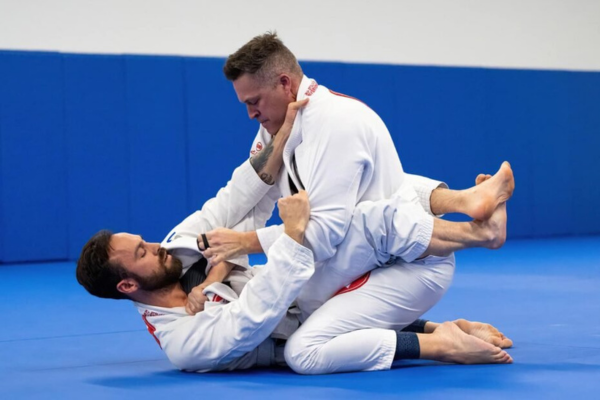Tapping in BJJ: When to give up?

Brazilian Jiu-Jitsu (BJJ) is a martial art in which technique, timing, and patience play a major role. One of the most important aspects for a beginner or advanced fighter to understand is when is the right time to “tap” or surrender. This topic is relevant for beginners, but remains an important topic of conversation for advanced practitioners as well.
In this article, we'll discuss what tapping is, why it's important, and how to decide when to give up.
What is 'tapping' in BJJ?
Tapping, or tapping, is a fighter’s way of signaling that he or she wants to quit. This is usually done in an uncomfortable or dangerous position, such as a submission (armbar or choke). Tapping with your hand or foot signals that you are quitting before you incur an injury. Tapping is essential for safety, as it prevents injuries and keeps training responsible.
Why are tap outs important?
Tapping is a crucial part of BJJ, especially for your safety. While it can be tempting to continue fighting, not tapping in time can lead to serious injuries. Tapping shows that you know your limits, respect your opponent, and want to train safely.
Physical cues: When to tap
Your body will give you signals that it's time to tap out. Here are some scenarios where you should consider giving up:
- Joint pain. When you are in an armbar or kimura, you may feel pain in the joint. Don't wait for the pain to get worse; as soon as you feel pressure, it's time to tap.
- Unable to breathe. Chokes, such as the rear-naked choke, restrict blood flow to your brain. Tapping before you lose consciousness is essential. Don’t wait until you see stars or feel dizzy.
- Losing freedom of movement. When you no longer have freedom of movement, such as with the mount, it may be time to give up. This prevents injury or suffocation.
The psychological aspect of tapping
Besides the physical signs, there is also a mental aspect to tapping. Many practitioners, especially beginners, struggle with their ego. They don’t want to give up because they think it’s a sign of weakness. It’s important to understand that tapping is a smart choice. It shows that you’re in a bad position and that it’s safer to tap than to take unnecessary risks.
1. Learn from your mistakes. By tapping, you give yourself the opportunity to learn. Instead of forcing yourself and getting injured, you can discuss after tapping what went wrong and how you can improve next time.
2. Focus on the long term. BJJ is a sport where consistency is key. Injuries can hinder your progress. By tapping smart, you will stay injury-free and continue to train and grow in the long term.
Tapping in competitions: There is no shame in it
In competition, tapping can be more difficult because of the pressure to win. However, there are many examples of top athletes tapping to avoid injury. Consider the match between Marcus "Buchecha" Almeida and Roger Gracie, where Buchecha chose to tap rather than injure himself.
There is no shame in tapping during a match. It shows that you respect the sport and stay healthy to be back on the mat next time.
Common misconceptions about tapping
There are some misconceptions about tapping, especially among beginners. Let's discuss some of these misconceptions:
- "Tapping is for the weak" This is a dangerous misconception. Tapping shows intelligence and respect for yourself and your opponent, not weakness.
- "You should always try to escape" While escape techniques are important, there are situations where escape is not possible without putting yourself in danger. In these cases, tapping is the better choice.
- "It is only necessary to tap in extreme pain" It is not necessary to get to the point of extreme pain. As soon as you feel that you are in a dangerous position, it is safe to tap.
How do you learn when to tap?
Learning the right time to tap takes practice and experience. Here are some tips:
- Pay attention to your body. Learn to recognize your body's signals. Know the difference between discomfort and real pain.
- Observe others. Watch more experienced practitioners and learn when they tap.
- Communicate with your training partners. Ask your partners how certain submissions feel and discuss when you should tap.
Communicating with your training partners
BJJ is about respect and teamwork, and communication is key. Discussing techniques and when to tap contributes to a safe training experience.
- Ask questions while rolling. Ask your training partners for clarification when you are unsure whether to tap. Learning more about techniques will increase your knowledge and safety on the mat.
- Post-training feedback. After a roll, it is useful to discuss how it went and when you should have tapped. This helps you learn faster and train more safely.
Tapping is a learning process
Tapping is an essential part of Brazilian Jiu-Jitsu. Knowing when to give up is important for your health and safety. It requires discipline and a good understanding of your own body. Remember that tapping is not a sign of weakness, but a sign of respect for yourself, your opponent, and the sport.
At Fightstyle we are passionate about the safety and growth of martial artists. We offer the best martial arts equipment and support you in your personal development within the sport. Stay safe on the mat and learn when to tap so you can prevent injuries and continue to train with pleasure.
 Nederlands
Nederlands English
English Deutsch
Deutsch Français
Français


Hoe weet je wanneer je echt moet tappen en niet gewoon kunt ontsnappen?
Leave a comment